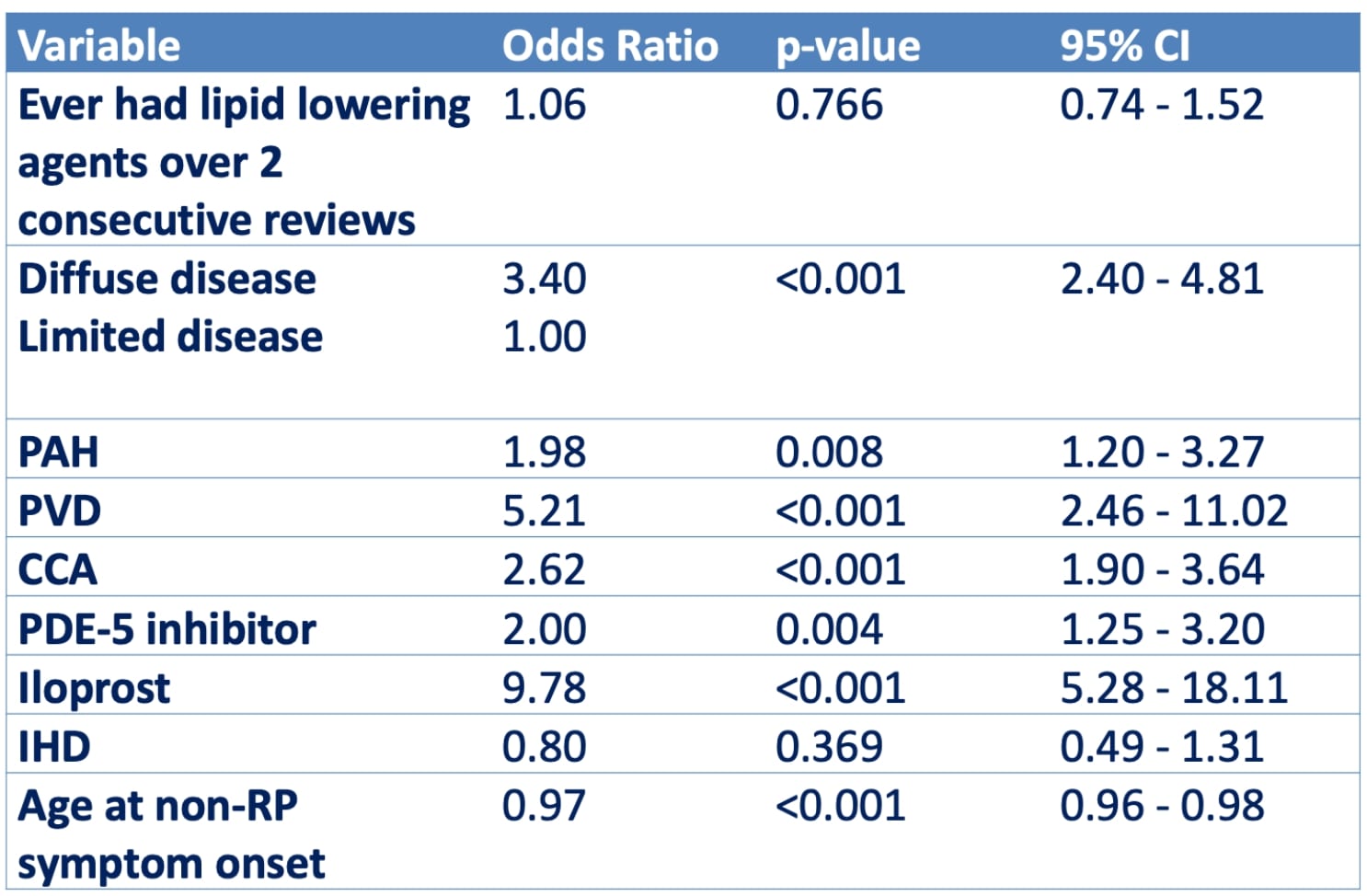Session Information
Date: Monday, November 8, 2021
Title: Systemic Sclerosis & Related Disorders – Clinical Poster II (1364–1390)
Session Type: Poster Session C
Session Time: 8:30AM-10:30AM
Background/Purpose: Digital ulcers (DU) are common in systemic sclerosis (SSc). Vasodilator therapies have limited benefit in prevention and promoting healing. Lipid-lowering agents (LLAs) such as statins reduce endothelial damage, increase vasodilation, and in small studies prevent new DU. This study examined whether LLAs have an impact on the prevalence of DU and overall survival in patients with SSc.
Methods: Data collected prospectively from the Australian Scleroderma Cohort Study between 2008 and 2020 included patient demographics, the presence of DU, vasodilator therapies, SSc manifestations and other vascular comorbidities. LLA use was defined as use of a LLA on two consecutive annual reviews. Multivariate longitudinal logistic modelling was used to assess associations with DU and a Kaplan-Meier (K-M) curve and multivariate cox proportional hazard modelling were used to assess survival by LLA use.
Results: Among 1485 patients, 323 patients (21.8%) had used a LLA. Patients in the LLA group were older at the onset of the first non-Raynaud’s symptom than patients in the non-LLA group (51.6 years vs 44.8 years, p = 0.001) and were more likely to have the anti-centromere antibody, interstitial lung disease, pulmonary arterial hypertension (PAH) and to have used calcium channel blockers. In a multivariate analysis (Table 1), the odds of ever having a DU were increased in males, patients with the diffuse subtype of SSc, pulmonary arterial hypertension (PAH) and those who received calcium channel blockers and vasodilators for PAH. Patients with peripheral vascular disease (PVD) were much more likely to have DU with an OR 5.21 (p = < 0.001; CI 2.46-11.02). There was a protective effect of older age, likely explained by survivor bias. There was no association of DU with LLA or other cardiovascular disease. In a multivariate model, LLA use was associated with reduced all-cause mortality (HR 0.60, p < 0.002, 95% CI 0.44-0.83). Patients with disease duration of less than 4 years receiving LLAs had worse survival than those not taking LLAs, with a hazard ratio of 2.41 (p = 0.002, 95% CI 1.38 – 4.20) but not when adjusted for age and gender.
Conclusion: DU prevalence was not influenced by LLA use but was strongly associated with PVD. While DU are traditionally considered to be related to local vasoconstriction and microvascular disease, macrovascular disease may also be an aetiological factor. LLA use was associated with reduced all-cause mortality but did not improve survival in patients with incident SSc who have the highest mortality early in the disease.
 Table 1: Multivariate logistic analysis of associations with digital ulcers
Table 1: Multivariate logistic analysis of associations with digital ulcers
To cite this abstract in AMA style:
Sallis O, Hansen D, Morrisroe K, Stevens W, Nikpour M, Proudman S. The Use of Lipid-Lowering Agents in Systemic Sclerosis: Is There a Relationship with Prevalence of Digital Ulcers and Overall Survival? [abstract]. Arthritis Rheumatol. 2021; 73 (suppl 9). https://acrabstracts.org/abstract/the-use-of-lipid-lowering-agents-in-systemic-sclerosis-is-there-a-relationship-with-prevalence-of-digital-ulcers-and-overall-survival/. Accessed .« Back to ACR Convergence 2021
ACR Meeting Abstracts - https://acrabstracts.org/abstract/the-use-of-lipid-lowering-agents-in-systemic-sclerosis-is-there-a-relationship-with-prevalence-of-digital-ulcers-and-overall-survival/
